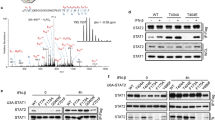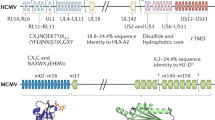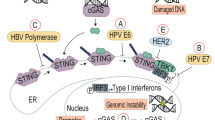Abstract
VIRAL infection of cells induces synthesis and release of interferon which renders uninfected cells resistant to subsequent virus infection. Interferon production can also be stimulated by non-viral agents, such as microorganisms1, substances of microbial origin and synthetic polymers2. Moreover, interferon can be stimulated in lymphocytes by mitogenic lectins3, antilymphocyte sera4, viral antigens5–7, PPD8 and exposure to allogeneic cells9. An antitumour effect of interferon and interferon inducers has been demonstrated in vivo10–12. It has been postulated that interferon may act by directly inhibiting tumour cell growth13 and by stimulating host defence mechanisms14–16. We report here that certain human cell lines are able to induce high levels of interferon on contact with human lymphocytes.
This is a preview of subscription content, access via your institution
Access options
Subscribe to this journal
Receive 51 print issues and online access
$199.00 per year
only $3.90 per issue
Buy this article
- Purchase on Springer Link
- Instant access to full article PDF
Prices may be subject to local taxes which are calculated during checkout
Similar content being viewed by others
References
Youngner, J. S. in Interferon (Little Brown, Boston, 1970).
Merigan, T. C. & Finkelstein, M. S. Virology 35, 363–376 (1968).
Wheelock, E. F. Science 149, 310–311 (1965).
Falcoff, R., Orzal, R. & Iscaki, S. Eur. J. Immun. 2, 476–478 (1976).
Glasgow, L. A. J. Bact. 91, 2185–2191 (1966).
Rasmussen, L. E., Jordan, G. W., Stevens, D. A. & Merigan, T. C. J. Immun. 112, 728–736 (1974)
Epstein, L. B., Stevens, D. A. & Merigan, T. C. Proc. natn. Acad. Sci. U.S.A. 69, 2632–2636 (1972).
Green, J. A., Cooperband, S. R. & Kibrick, S. Science 164, 1415–1417 (1969).
Gifford, G. E., Tibor, A. & Peavy, D. L. Infect. Immun. 3, 164–166 (1971).
Atanasiu, P. & Chany, C. C. r. hébd. Séanc. Acad. Sci., Paris 251, 1687–1689 (1960).
Gresser, I. et al. C. r. hébd. Séanc. Acad. Sci. 268, 994–997 (1969); Proc. natn. Acad. Sci. U.S.A. 63, 51–57 (1969).
Gresser, I. in Advances in Cancer Research (eds Klein, G. & Weinhouse, S.) (Academic, New York and London, 1972).
Paucker, K., Cantell, K. & Henle, W. Virology 17, 324–334 (1962).
Chernyakhovskaya, I. Y., Slavina, E. G. & Svet-Molavsky, G. L. Nature 228, 71–72 (1970).
Lindhal, P., Leary, P. & Gresser, I. Proc. natn. Acad. Sci. U.S.A. 69, 721–725 (1972).
Huang, K. Y., Donahoe, R. M., Gordon, F. B. & Dressler, H. R. Infect. Immun. 4, 581–588 (1971).
Weiss, M. C., Ephrussi, B., Scalletta, L. J. Proc. natn. Acad. Sci. U.S.A. 59, 1132–1135 (1968).
Croce, C. M., Girardi, A. J. & Koprowski, H. Proc. natn. Acad. Sci. U.S.A. 72, 1397–1400 (1975).
Santoli, D., Wroblewska, Z., Gilden, D. H., Girardi, A. & Koprowski, H. J. comp. Neurol. 161, 317–328 (1975).
Leibovitz, A. et al. Cancer Res. 36, 4562–4569 (1976).
McAllister, R. M., Nelson-Rees, W. A., Johnson, E. Y., Rongey, R. W. & Gardner, M. B. J. natn. Cancer Inst. 47, 603–612 (1971).
Rasheed, S., Nelson-Rees, W. A., Toth, E. M., Arnstein, P. & Gardner, M. B. Cancer 33, 1027–1033 (1974).
Nelson-Rees, W. A. & Flandermayer, R. R. Science 191, 96–98 (1976).
Lockart, R. Z., Jr Interferons and Interferon Inducer (ed. N. B. Finter) 11–27 (North-Holland, Amsterdam, 1973).
Stewart, W. E. II et al. Nature 246, 141–143 (1973).
Santoli, D., Trinchieri, G., Zmijewski, C. M. & Koprowski, H. J. Immun. 117, 765–770 (1976).
Author information
Authors and Affiliations
Rights and permissions
About this article
Cite this article
TRINCHIERI, G., SANTOLI, D. & KNOWLES, B. Tumour cell lines induce interferon in human lymphocytes. Nature 270, 611–613 (1977). https://doi.org/10.1038/270611a0
Received:
Accepted:
Issue Date:
DOI: https://doi.org/10.1038/270611a0
This article is cited by
-
Regulation of cell growth by interferon
Cancer and Metastasis Review (1987)
-
In vitro response of cells from three patients with hairy cell leukemia to a recombinant leukocyte interferon
Virchows Archiv B Cell Pathology Including Molecular Pathology (1985)
-
Immune responses of DBA/2 mice bearing melanoma tumors: Cell-mediated immune responses after challenge with vaccinia virus
Cancer Immunology, Immunotherapy (1983)
Comments
By submitting a comment you agree to abide by our Terms and Community Guidelines. If you find something abusive or that does not comply with our terms or guidelines please flag it as inappropriate.



